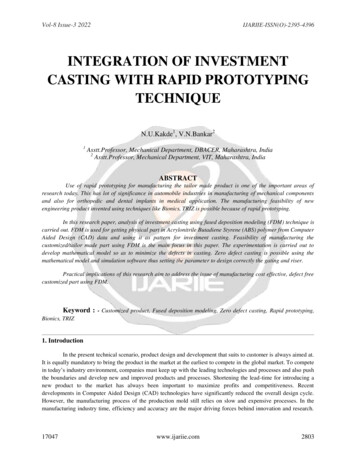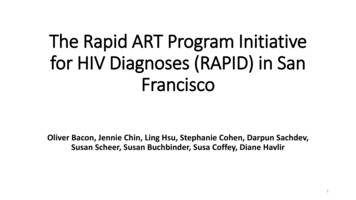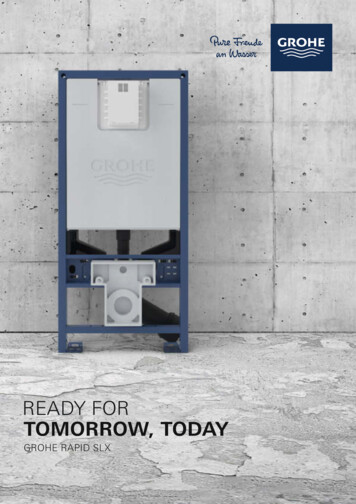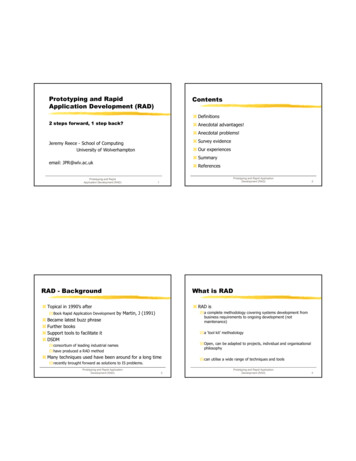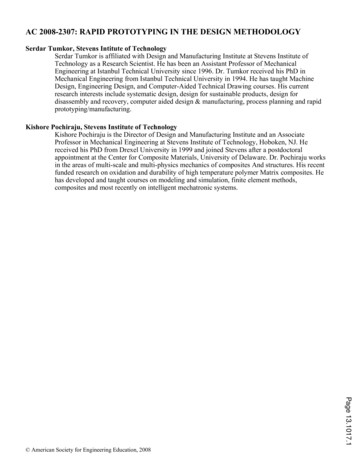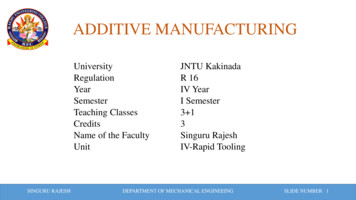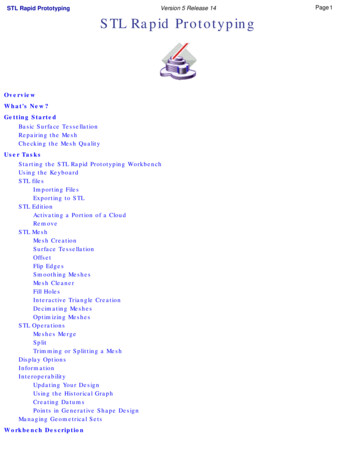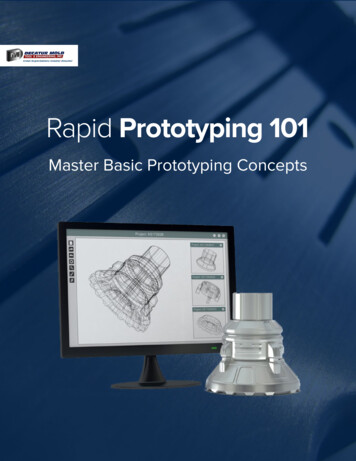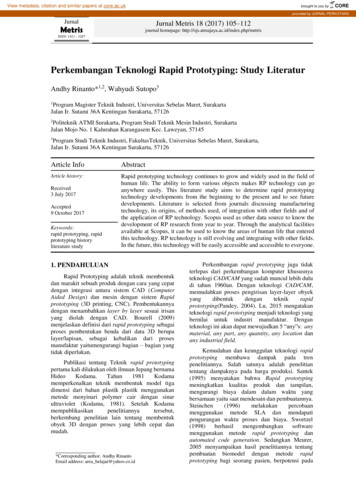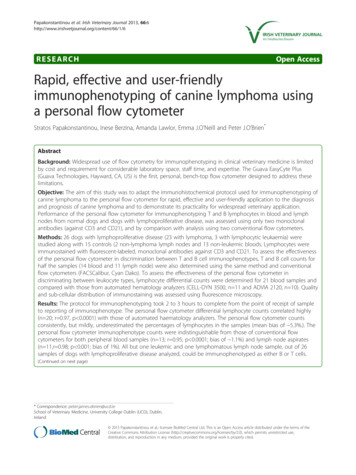
Transcription
Papakonstantinou et al. Irish Veterinary Journal 2013, ris Tréidliachta ÉireannRESEARCHOpen AccessRapid, effective and user-friendlyimmunophenotyping of canine lymphoma usinga personal flow cytometerStratos Papakonstantinou, Inese Berzina, Amanda Lawlor, Emma J.O’Neill and Peter J.O’Brien*AbstractBackground: Widespread use of flow cytometry for immunophenotyping in clinical veterinary medicine is limitedby cost and requirement for considerable laboratory space, staff time, and expertise. The Guava EasyCyte Plus(Guava Technologies, Hayward, CA, US) is the first, personal, bench-top flow cytometer designed to address theselimitations.Objective: The aim of this study was to adapt the immunohistochemical protocol used for immunophenotyping ofcanine lymphoma to the personal flow cytometer for rapid, effective and user-friendly application to the diagnosisand prognosis of canine lymphoma and to demonstrate its practicality for widespread veterinary application.Performance of the personal flow cytometer for immunophenotyping T and B lymphocytes in blood and lymphnodes from normal dogs and dogs with lymphoproliferative disease, was assessed using only two monoclonalantibodies (against CD3 and CD21), and by comparison with analysis using two conventional flow cytometers.Methods: 26 dogs with lymphoproliferative disease (23 with lymphoma, 3 with lymphocytic leukaemia) werestudied along with 15 controls (2 non-lymphoma lymph nodes and 13 non-leukemic bloods. Lymphocytes wereimmunostained with fluorescent-labeled, monoclonal antibodies against CD3 and CD21. To assess the effectivenessof the personal flow cytometer in discrimination between T and B cell immunophenotypes, T and B cell counts forhalf the samples (14 blood and 11 lymph node) were also determined using the same method and conventionalflow cytometers (FACSCalibur, Cyan Dako). To assess the effectiveness of the personal flow cytometer indiscriminating between leukocyte types, lymphocyte differential counts were determined for 21 blood samples andcompared with those from automated hematology analyzers (CELL-DYN 3500, n 11 and ADVIA 2120, n 10). Qualityand sub-cellular distribution of immunostaining was assessed using fluorescence microscopy.Results: The protocol for immunophenotyping took 2 to 3 hours to complete from the point of receipt of sampleto reporting of immunophenotype. The personal flow cytometer differential lymphocyte counts correlated highly(n 20; r 0.97, p 0.0001) with those of automated haematology analyzers. The personal flow cytometer countsconsistently, but mildly, underestimated the percentages of lymphocytes in the samples (mean bias of 5.3%.). Thepersonal flow cytometer immunophenotype counts were indistinguishable from those of conventional flowcytometers for both peripheral blood samples (n 13; r 0.95; p 0.0001; bias of 1.1%) and lymph node aspirates(n 11,r 0.98; p 0.001; bias of 1%). All but one leukemic and one lymphomatous lymph node sample, out of 26samples of dogs with lymphoproliferative disease analyzed, could be immunophenotyped as either B or T cells.(Continued on next page)* Correspondence: peter.james.obrien@ucd.ieSchool of Veterinary Medicine, University College Dublin (UCD), Dublin,Ireland 2013 Papakonstantinou et al.; licensee BioMed Central Ltd. This is an Open Access article distributed under the terms of theCreative Commons Attribution License (http://creativecommons.org/licenses/by/2.0), which permits unrestricted use,distribution, and reproduction in any medium, provided the original work is properly cited.
Papakonstantinou et al. Irish Veterinary Journal 2013, age 2 of 14(Continued from previous page)Conclusions: We conclude that use of only 2 monoclonal antibodies is sufficient for immunophenotyping mostcases of canine lymphoma by flow cytometry and enables rapid immunophenotyping. The personal flow cytometermay be as effectively used for immunophenotyping canine lymphoma as conventional flow cytometers. However,the personal flow cytometer is more accessible and user-friendly, and requires lower sample volumes.Keywords: Immunophenotyping, Canine lymphoma, Personal flow cytometer, Microfluidics, GuavaBackgroundLymphoma is one of the most prevalent cancers in dogs[1]. Diagnostic testing and prognosis is based on clinicalsigns and degree of spread, morphological features ofthe lymph node and lymphocytes, and other cytopathologic features such as mitotic rate, and clonality ofantigen-receptor rearrangement or of cluster of differentiation (CD) antigens.Immunophenotyping CD antigens has contributed significantly to both diagnosis and prognosis of lymphoidneoplasia. This approach measures the binding of labelled, monoclonal antibodies to specific intracellular orsurface CD antigens. It is well-established and has longbeen used in cell analysis, particularly in the fields ofhaematology and immunology [2-4]. For lymphoma, itcan be accomplished using either immunohistochemistryof tissue-biopsy sections [5] or by immunocytochemistryof fine needle aspirates. Cytologic analysis can be donemanually on smears using microscopy [6] or on cell suspensions using automated, flow cytometry.Immunophenotyping is most easily and rapidly accomplished by flow cytometry. Flow cytometry of blood,lymph node and bone marrow samples may improve evaluation and prognosis of dogs with lymphoma [4,7-9].However, in veterinary medicine this technique is mainlyavailable only as a research tool, rather than for widespread diagnostic use as occurs in human medicine [9].There are only a few European laboratories that routinelyprovide immunophenotyping by flow cytometry for veterinary patients. The main barriers associated with the expansion of flow cytometry in veterinary medicine are thesubstantial cost of the analyser, reagents, and facilities, andthe need for advanced training of the instrument operators. In addition, analysis and interpretation of results requires understanding and knowledge of flow cytometryand its principles.It is well documented that immunophenotype of neoplastic lymphocytes correlates significantly with the survival time of dogs with lymphoma and is of significantvalue in prognosis [10-15]. In 175 dogs with lymphomas,T-cell phenotype had shorter relapse-free time (52 versus160 days, p 0.001) and shorter survival times (153 versus330 days, p 0.001) than B-cell phenotype [15]. Dobson,Blackwood et al. 2001 found that the T- cell phenotypeis associated with a significantly shorter recurrence-freeinterval and reduced survival times. Hazard ratio forT-cell versus B-cell immunophenotype lymphoma was4, with 95% confidence interval from 1.4 to 11.3, p 0.035.However, the correlation of immunophenotype with prognosis is not perfect, and exceptions have been identified.For example, the small and clear T-cell lymphoma hasone of the best prognoses [11]. Thus for prognosis, immunophenotyping data must be used along with otherclinical and cytological assessments of degree of spread,morphologic features, and mitotic rate.In recent years, multiple research studies involvingimmunophenotyping by flow cytometry have been published in the veterinary literature [2-4,6,15-20]. However,limited veterinary availability of flow cytometers, expertise, and reagents is a major limitation to the diagnosticuse of immunophenotyping [9]. Also, the current protocols used in veterinary diagnostics are labour intensiveand time-consuming, involve standard technology, andhave not been customised for widespread diagnostic usein the clinical pathology laboratory.The recent development of the personal flow cytometer may overcome the barriers previously associatedwith diagnostic use of flow cytometry in veterinary medicine. The personal flow cytometer is a miniaturised,user-friendly, and affordable version of the standard instrument [21] found in dedicated facilities and operatedby dedicated personnel. Different manufacturers namethe instruments they produce “personal”. Such instruments include the different Guava platforms producedby Millipore, the Accuri C6 from BD Biosciences, theAttune flow cytometer by Applied Biosystems and theHPC-100 system by Handyem. The technical bulletin forthe Accuri C6 analyzer from BD Biosciences is entitled“Making Flow Cytometry Personal”[22] They can beused in any laboratory and by any laboratory technologist, and seem ideal for the veterinary clinical pathologylaboratory.The Guava flow cytometer (Guava Technologies,Hayward, CA, US) is the first, such personal flow cytometer, and has several advantageous features for veterinary use. It is an automated, easy-to-use, bench-top,single-cell, analyser that can perform a wide range ofmulti-parameter, cell-based assays using light scatter andmultiple fluorescence measurements and also direct measurement of cell counts without the need for reference
Papakonstantinou et al. Irish Veterinary Journal 2013, eads [23]. It requires far less sample and reagents volume[24], making it ideal for veterinary and diagnostic cytologyapplications. It requires far less operator time and expertise, less maintenance and is automated for multiple tubeor microtiter plate sampling. It requires far less benchspace than the standard analyser. The purchase cost isconsiderably lower than conventional flow cytometers.Also, it does not produce voluminous waste, because itdoes not use sheath fluid to move the cells through theanalyser [21].The aim of this study was to adapt the immunochemical protocol used for immunophenotyping of caninelymphoma to the personal flow cytometer for rapid, effective and user-friendly application to diagnosis andprognosis of canine lymphoma and to demonstrate itspracticality for widespread veterinary application. Partsof this study have also been presented in the 10th and13th Annual Congresses of the European Society of Veterinary Clinical Pathology in Barcelona, Spain and Dublin,Ireland [25,26].MethodsSubjectsSamples from 58 dogs were obtained: a) 21 peripheralblood samples (of which 1 was leukemic) were used toassess the ability of the personal flow cytometer to effectively discriminate lymphocytes from other leukocytes, based on forward and side light scatter (4 ofthese were also immunophenotyped). The non-leukemicsamples were obtained from non-lymphopenic dogsthat presented to the University Veterinary Hospital inDublin for a variety of reasons other than lymphoma/leukaemia. b) 41 samples were used to assess the abilityof the personal flow cytometer to immunophenotype: 23were lymph node aspirates from dogs with lymphoma, 2were lymph node aspirates from lymphoma-free dogs,13 were non-leukemic peripheral blood samples and 3were leukemic blood samples. Of the 41 samples, immunophenotyping results for 25 (14 peripheral bloodsand 11 lymph node aspirates) were compared betweenthe personal flow cytometer and the conventional analyzers, and 16 were analyzed on the Guava only as noother analyzer was available. All investigations wereundertaken within the guidelines of the UCD AnimalResearch and Ethics Committee.Flow cytometryInstrumentationThe Guava EasyCyte Plus is equipped with a 20 mW,argon-ion laser of 488 nm, a forward-scatter (FSC) detector, a side-scatter (SSC) detector, and four fluorescencedetectors (525/30 nm, 583/26 nm, 680/30 nm, and 785/70 nm). The Cyan Dako was equipped with three lasers(488 nm, 635 nm and 405 nm) and the BD FACSCaliburPage 3 of 14with 2 lasers operating at 488 and 635 nm. The GuavaExpressPro software program (version 5.0) was used forsample data acquisition on the Guava, and the dedicatedsoftware for the other analyzers (Dako Summit and BDFACStation respectively).Data acquisitionGating strategy and protocol setup was the same for allinstruments. When acquiring data, a lymphocyte gatewas defined, based on the size and granularity of lymphocytes depicted on the forward scatter versus sidescatter plot. A debris threshold was set to eliminateevents having low forw
by Millipore, the Accuri C6 from BD Biosciences, the Attune flow cytometer by Applied Biosystems and the HPC-100 system by Handyem. The technical bulletin for the Accuri C6 analyzer from BD Biosciences is entitled "Making Flow Cytometry Personal"[22] They can be used in any laboratory and by any laboratory technolo-



